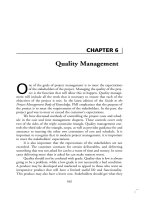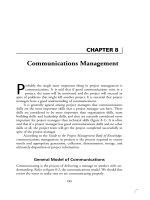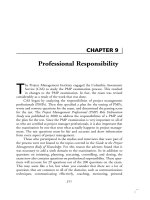Space project management - Cost and schedule management ppt
Bạn đang xem bản rút gọn của tài liệu. Xem và tải ngay bản đầy đủ của tài liệu tại đây (906.74 KB, 85 trang )
ECSS-M-ST-60C
31 July 2008
Space project
management
Cost and schedule management
ECSS Secretariat
ESA-ESTEC
Requirements & Standards Division
Noordwijk, The Netherlands
ECSS‐M‐ST‐60C
31July2008
Foreword
This Standard is one of the series of ECSS Standards intended to be applied together for the
management, engineering and product assurance in space projects and applications. ECSS is a
cooperative effort of the European Space Agency, national space agencies and European industry
associationsforthepurposeofdevelopingandmaintainingcommonstandards.Requirementsinthis
Standardaredefinedintermsofwhatshallbeaccomplished,ratherthanintermsofhowtoorganize
and perform the necessary work. This allows existing organizational structures and methods to be
appliedwherethey are effective,and forthe structures andmethods to evolveasnecessary without
rewritingthestandards.
This Standard has been prepared by the ECSS‐M‐ST‐60 Working Group, reviewed by the ECSS
ExecutiveSecretariatandapprovedbytheECSSTechnicalAuthority.
Disclaimer
ECSSdoesnotprovideanywarrantywhatsoever,whetherexpressed,implied,orstatutory,including,
butnotlimitedto,anywarrantyofmerchantabilityorfitnessforaparticularpurposeoranywarranty
that the contents of the item are error‐free. In no respect shall ECSS incur any liability for any
damages,including,butnotlimitedto, direct,indirect,special,orconsequentialdamagesarisingout
of, resulting from,or in any way connected to the use of this Standard, whetheror not based upon
warranty,businessagreement,tort, or otherwise;whetherornotinjury wassustained bypersons or
propertyorotherwise;andwhetherornotlosswassustainedfrom,oraroseoutof,theresultsof,the
item,oranyservicesthatmaybeprovidedbyECSS.
Publishedby: ESARequirementsandStandardsDivision
ESTEC, P.O. Box 299,
2200 AG Noordwijk
The Netherlands
Copyright: 2008 © by the European Space Agency for the members of ECSS
2
ECSS‐M‐ST‐60C
31July2008
Change log
ECSS‐M‐60A
19April1996
Firstissue
ECSS‐M‐60B
26June2006
Secondissue
ECSS‐M‐ST‐60C Thirdissue
31July2008 ThefollowingisasummaryofchangesfromECSS‐M‐60B:
• TheWorkbreakdownstructure(WBS)DRDhasbeenextractedand
movedintoECSS‐M‐ST‐10.
• Informativeannexon“DeterminationoftheappropriateWBSlevelof
detailed”hasbeenextractedandmovedintoECSS‐M‐ST‐10.
• Requirement7.1.1inissueB,hasbeendeletedbecausecoveredby
requirementsinECCS‐M‐ST‐10.
• Informative
AnnexPwasadded,containingPSSformsA1,A8,A10.
• EditorialchangestoconformtotheECSSstandardtemplate.
3
ECSS‐M‐ST‐60C
31July2008
Table of contents
1 Scope 9
2 Normative references 10
3 Terms, definitions and abbreviated terms 11
3.1 Terms from other standards 11
3.2 Terms specific to the present standard 11
3.3 Abbreviated terms 12
4 Cost and schedule management common principles 13
4.1 Objectives and relationships 13
4.2 Project structure 14
4.2.1 Work breakdown structure 14
4.2.2 Cost breakdown structure 15
4.2.3 Business agreement Structure 15
4.2.4 Country/Company structure 16
4.3 Business agreement types 17
4.3.1 General 17
4.3.2 Fixed price contracts 17
4.3.3 Cost reimbursement contracts 17
4.3.4 Ceiling price to be converted into fixed price 18
4.4 Risk management 18
4.4.1 General description 18
4.4.2 Risk register 19
4.4.3 Lessons learned 19
5 Schedule management principles 20
5.1 Schedule definition 20
5.1.1 General 20
5.1.2 Activities definition / Activities sequencing 20
5.1.3 Key milestones 21
5.1.4 Resource allocation 21
5.2 Schedule control 21
4
ECSS‐M‐ST‐60C
31July2008
5.2.1 Baseline schedule 21
5.2.2 Current working schedule 22
5.2.3 Performance evaluation 23
5.3 Schedule reporting 25
5.3.1 General 25
5.3.2 Schedule progress information 25
5.3.3 Reporting system and tools 25
6 Cost management principles 27
6.1 General 27
6.2 Contractual and financial interfaces 27
6.2.1 Audited rates and cost structure 27
6.2.2 Currency and exchange rates 27
6.2.3 Contract change notice (CCN) 28
6.3 Cost estimating and planning 28
6.3.1 Cost estimating 28
6.3.2 Development cost plan (DCP) 30
6.3.3 Payment plans 31
6.3.4 Price variation mechanism 31
6.3.5 Geographical distribution 32
6.3.6 Inventory control plan 32
6.4 Cost control 32
6.4.1 Baseline cost plan 32
6.4.2 Estimate at completion (EAC) and estimate to completion (ETC) 33
6.4.3 Price variation 33
6.4.4 Geographical distribution control 34
6.4.5 Inventory control 34
6.4.6 Financial audits 34
6.4.7 Payment milestone achievement 34
6.5 Cost reporting 35
6.5.1 Reports applicable to all contract types 35
6.5.2 Reports specific to cost reimbursement contracts 35
7 Cost and schedule management common requirements 36
7.1 Project structure 36
7.1.1 Cost breakdown structure 36
7.1.2 Business agreement structure 36
7.1.3 Country/Company structure (CCS) 36
7.2 Risk management 36
5
ECSS‐M‐ST‐60C
31July2008
8 Schedule management requirements 37
8.1 Schedule definition 37
8.2 Schedule control 37
8.3 Schedule reporting 38
9 Cost management requirements 39
9.1 Contractual and financial interfaces 39
9.1.1 Audited rates and cost structure 39
9.1.2 Economic conditions 39
9.1.3 Currency and exchange rates 39
9.1.4 Contract change procedure 39
9.2 Cost estimating and planning 39
9.2.1 Cost estimating 39
9.2.2 Project financial information 40
9.2.3 Development cost plan (DCP) 40
9.2.4 Milestone payment plans 40
9.2.5 Price variation mechanism 40
9.2.6 Geographical distribution 40
9.3 Cost control 41
9.3.1 Original baseline cost plan 41
9.3.2 Current baseline cost plan 41
9.3.3 Estimate at completion (EAC) and estimate to completion (ETC) 41
9.3.4 Price variation mechanism 42
9.3.5 Geographical distribution control 42
9.3.6 Inventory control 42
9.3.7 Financial audits 42
9.3.8 Payment milestone achievement 43
9.4 Cost management reporting 43
9.4.1 Cost and manpower report 43
9.4.2 Inventory record 43
Annex A (normative) Cost breakdown structure - DRD 44
Annex B (normative) Schedule - DRD 47
Annex C (normative) Schedule progress report - DRD 48
Annex D (normative) Company price breakdown forms - DRD 49
Annex E (normative) Geographical distribution report - DRD 51
Annex F (normative) Cost estimating plan - DRD 52
6
ECSS‐M‐ST‐60C
31July2008
Annex G (normative) Cost estimate report - DRD 55
Annex H (normative) Milestone Payment Plan - DRD 58
Annex I (normative) Inventory record - DRD 59
Annex J (normative) Cost and manpower report - DRD 61
Annex K (normative) OBCP and CBCP for cost reimbursement - DRD 63
Annex L (normative) OBCP and CBCP for fixed price - DRD 65
Annex M (normative) EAC and ETC for cost reimbursement - DRD 67
Annex N (normative) EAC for fixed price - DRD 69
Annex O (normative) Contract change notice (CCN) - DRD 71
Annex P (informative) ESA PSS Forms A2, A8 and A10 72
Annex Q (informative) Cost estimating methods 80
Annex R (informative) Inventory Control 83
Figures
Figure 4-1: Overall functional analysis 14
Figure 4-2: Business agreement structure example 16
Figure 4-3: Business agreement structure schematic 16
Figure 5-1: Gantt chart example 23
Figure 5-2: Milestone trend chart example 24
Figure 5-3: Milestone list example 24
Figure A-1 : CBS 45
Tables
Table Q-1 : Cost estimate method vs. project phase 80
7
ECSS‐M‐ST‐60C
31July2008
Introduction
Cost and schedule management is defined as a collective system of organized
processesandactionsinsupport ofprojectmanagement.Itallowsoptimaluse
to be made of human resources, facilities, materials and funds, thereby
achievingasuccessfulcompletionofthespaceprojectwithrespectto
• costtargets,
• timelycompletion,and
• technicalperformance.
To this end, costs and activities are planned and actively controlled, with
specialcarebeinggiventotheidentificationofcriticalsituationsthatcanleadto
an adverse impact on the project cost and schedule, so that the relevant
recoveryactionscanbeproposed.
8
ECSS‐M‐ST‐60C
31July2008
1
Scope
The requirements specified herein apply to, and affect the customer and
supplieratalllevels.
Thisstandardmaybetailoredforthespecificcharacteristicsandconstraintsofa
spaceprojectinconformancewithECSS‐S‐ST‐00.
9
ECSS‐M‐ST‐60C
31July2008
2
Normative references
The following normative documents contain provisions which, through
reference in this text, constitute provisions of this ECSS Standard. For dated
references,subsequentamendmentsto,orrevisionsofanyofthesepublications
donotapply.However,partiestoagreementsbasedonthisECSSStandardare
encouragedtoinvestigatethepossibilityofapplyingthemostrecenteditionsof
the normative documents indicated below. For undated references, the latest
editionofthenormativedocumentreferredtoapply.
ECSS‐S‐ST‐00‐01 ECSSsystem–Glossaryofterms
ECSS‐M‐ST‐10 Spaceprojectmanagement–Projectplanningand
implementation
ECSS‐M‐ST‐80
Spaceprojectmanagement–Riskm anagement
10
ECSS‐M‐ST‐60C
31July2008
3
Terms, definitions and abbreviated terms
3.1 Terms from other standards
For the purpose of this Standard, the terms and definitions from ECSS‐S‐
ST‐00‐01apply,inparticularforthefollowingterms:
costbreakdownstructure
estimate(cost)atcompletion
estimate(cost)tocompletion
3.2 Terms specific to the present standard
3.2.1 cost reimbursement contract
generic type of business agreement in which payments are depending upon
incurredcosts
3.2.2 cost estimating
processhelpinginthedeterminationoftheexpectedcostsofaproject
3.2.3 critical path
chainofactivitiescriticaltothetimelycompletionoftheproject
3.2.4 direct manpower cost
manpowercostchargedtotheprojectusingtheagreedrates
3.2.5 economic conditions
reference period of time during which a set of financial elements (e.g. hourly
ratesandoverheads)areapplicable
NOTE Reference economic conditions are those
prevailing when the decision to commit to the
project is taken. Current economic conditions are
the conditions prevailing when the service is
provided.
11
ECSS‐M‐ST‐60C
31July2008
3.2.6 fixed price contract
generic type of business agreement in which payments are de fined in the
business agreement in the form of milestone payment plan(s), and depend
upontheachievementoftherelevantcontractualmilestones
3.3 Abbreviated terms
For the purpose of thisStandard,the abbreviated termsfrom ECSS‐S‐ST‐00‐01
andthefollowingapply:
Abbreviation Meaning
AIV
assembly,integrationandverification
CBCP
currentbaselinecostplan
CBS
costbreakdownstructure
CCN
contractchangenotice
CCS
country/companystructure
CIL
criticalitemslist
CPM
criticalpathmethod
CR
costreimbursement
CWP
controlworkpackage
DCP
developmentcostplan
DIL
deliverableitemslist
EAC
estimateatcompletion
EC
economicconditions
ETC
estimatetocompletion
FP
fixedprice
FFP
firmfixedprice
G&A
general&administrative
MPP
milestonepaymentplan
MTA
milestonetrendanalysis
MTC
milestonetrendchart
OBCP
originalbaselinecostplan
PDM
precedencediagrammethod
PMAC
paymentmilestoneachievementcertificate
PEF
priceescalationformula
PSS
procedurestandardspecification
PT
producttree
WBS
workbreakdownstructure
12
ECSS‐M‐ST‐60C
31July2008
4
Cost and schedule management
common principles
4.1 Objectives and relationships
Cost and schedule management is a major factor in the effective, responsible
and proactive controlling of projects. It provides a common working baseline
for the planning and expenses and across the participants of the project. It
ensures a uniform ba sis and common understanding of the project planning,
costandmanpowertargetsforusebyallparticipants.
ThemainobjectivesofCostandSchedulemanagementareto:
• planaccuratelythephasingofprocurements,expensesandresourcesfor
theproject;
• highlight any deviations and hence propose remedial actions, with the
aim of completing the project within the given time and financial
constraints.
Schedule managementincludes the activities to accomplish timely completion
oftheproject,i.e.:
• Scheduledefinition,includingactivitydefinitionandsequencing,activity
durationestimatingandschedulebaselineestablishment;
• Schedulecontrol,includingthecomparisonbetweenthecurrentworking
scheduleandthebaselineschedule;
• Schedulereporting.
Cost management includes the activities to complete the project within the
approvedbudget,i.e.
• Costestimatingandplanning;
• Costcontrol;
• Costreporting.
Themainstructurestoperformtheseactivitiesarethe:
• Workbreakdownstructure;
• Costbreakdownstructure;
• Businessagreementstructure;
• Country/companystructure.
13
ECSS‐M‐ST‐60C
31July2008
Figure 4‐1 presents an overall functional analysis of cost and schedule
management.
Cost management
WBS / Business agreement
Project schedule
(baseline & current)
Constraints and risks
Resource development plan
Cost and schedule project plan
Performance report
OBCP / CBCP and MPP
Cost estimates (EAC and ETC)
Task definition, duration and sequencing
Schedule management
Schedule report (progress status, performances, delivery and trends)
Project milestones
CBS and CCS (+geo return)
Inventory control plan
Audit
Geographical distribution
CCN
Financial elements (Company cost element data sheet, Company price breakdown forms, Manpower and
price summary, Work package manpower and cost plan, Price variation mechanism)
Report (Performance measurement, Contract
close out report, payment and commitment
status report, Inventory record
)
Figure4‐1:Overallfunctionalanalysis
4.2 Project structure
4.2.1 Work breakdown structure
Ageneral introduction intothe Work BreakdownStructure(WBS) is provided
inECSS‐M‐ST‐10.
InthespecificcontextofCostandSchedulemanagement,theWBSisusedasa
commontoolintheproject,assistingitsparticipantsin:
• Conductingtendercomparisonsandbusinessagreementnegotiations;
• Optimizingthedistributionofworkamongstthedifferentsuppliers;
• Monitoringthescheduleoftheproject:
A network of events (e.g. start, complete) and activities (e.g. de sign,
develop and operate) takes place. The logical relationships between the
activities allow the producing and completing of the WBS deliverables.
Resources(e.g.labourskill,andmaterials)andresponsibleorganizations
(e.g. mechanical engineering department, fabrication department,
supplier)canthenbeidentifiedforeachactivity.
The scope and complexity of the work and the management needs for
schedule visibility influence the frequency of schedule reporting and
theirassociatedlevelsofdetail.
14
ECSS‐M‐ST‐60C
31July2008
• Estimating,planningandmonitoringthecost:
By breaking down the total product tree into successively smaller
elementsandsupportfunctions,managementcanverifythatallactivities
identified in the WBS actually contribute to the project objectives. In
addition,usingWBSelementstoplanfortheworkservesasthebasisfor
estimatingandschedulingresourceneeds.
Anestimatebasedon WBS elementshelpstoplan,coordinate,andcontrol the
various project activities that both the customer and the suppliers are
conducting. The WBS also provides a common framework for tracking the
evolution of estimates, he nce forecasting the total cost of the project more
accurately.
ProperuseoftheWBSfortechnical,schedule,andcostmanagementallowsthe
defining of work and related resources, ensuring that all work is included
without duplication of effort. In addition, the WBS is used to accumulate
performance data and associated variances to evaluate progress in terms of
performance.
To perform data reporting, the WBS is broken down into work‐packages. All
definedwork‐packagesreflectthetotalworkscope.
Any reporting to the customer is performed using Control work‐packages,
which are agreed between the customer and the supplier and reflected in the
corresponding business agreement. All defined Control work‐packages also
reflectthetotalworkscope.
4.2.2 Cost breakdown structure
The Cost Breakdown Structure (CBS) defines a set of cost categories used to
breakdownallthecostsoftheproject.Itprovidesacommonframeworkforall
costmanagementactivitiesamongsuppliersforthesameproject.
Thetotalcostplannedforeachworkpackageisbrokendownpercostcategory
(e.g. labour, non‐labour, subcontracts). For each cost category, the distinction
betweendirectandindirectcostsisidentifiedbyeachsuppliertothecustomer.
4.2.3 Business agreement Structure
A Business Agreement Structure is a specific type of organization chart, the
purposeof which is toidentify the projectreportingrelationshipsbetween the
respective customers and suppliers. It shows which suppliers are responsible
forwhichworkpackages,asdepictedin
Figure4‐2.
15
ECSS‐M‐ST‐60C
31July2008
Supplier 1
Service Module
Supplier 6
Electrical system
Supplier 2
Payload Module
Supplier 3
AIV
Supplier 4
Risk Magt
Supplier 5
PA support
Supplier 9
Structure
Supplier 11
Propulsion
Supplier 7
Structure
Supplier 8
EGSE
Supplier 10
Reflector
Prime Contractor
Figure4‐2:Businessagreementstructureexample
By relatingwork packages in theWBS tobusiness agreements in theBusiness
AgreementStructure,contractualresponsibilitiescanbetraced.Itfacilitatesthe
cost management process by providing the means to ensure that all impacts
(e.g. liability, financial, technical or schedule) of a change in the business
agreement are properly assessed at all levels of the contractual hierarchy (see
Figure4‐3).
Prime level
Sub-level 1
OBS
Sub-level 2
Sub-level n
WBS
Figure4‐3:Businessagreementstructureschematic
4.2.4 Country/Company structure
The Country/Company Structure (CCS) shows the relationships between each
companyʹs business agreement for a project and the countries in which the
corresponding work is performed. By identifying the relati onships between
workpackagesintheWBSandbusinessagreementsintheCCS,reportscanbe
generatedtoillustratehoweachsupplier’sworkisdistributedpercountry,e.g.
forgeographicalreturnpurposes.
Inthe case ofprojectswhereit is simple toidentifythecountriesin which the
works are performed, the CCS is combined with the Business Agreement
Structure.
16
ECSS‐M‐ST‐60C
31July2008
4.3 Business agreement types
4.3.1 General
The way tomanage thecostand scheduleaspects ofa project depends on the
business agreement type. There are two ba sic types: Fixed Price and Cost
Reimbursement,whicharebrokendownasdefinedbelow.
4.3.2 Fixed price contracts
a. Firmfixedprice:thepriceofthebusinessagreementisnotsubjecttoany
adjustment or revision by reason of the actual costs incurred by the
supplierintheperformanceofhisbusinessobligations.
b. Fixed price with variation: the price of the business agreement is not
subject to any adjustment or revision by reason of the actual costs
incurred by the supplier inthe performance of his business obligations,
except for the update to current economic conditions by applying an
agreedpricevariationmechanism.
c. Fixed unit price:the priceof the businessagreement isdefinedper unit
priceofthevarioussuppliesandservices.
4.3.3 Cost reimbursement contracts
a. Costplusfixedfee:itisacost‐reimbursementtypeofbusinessagreement
which provides for the payment of a fixed fee to the supplier. Its
implementation mechanism is described in the business agreement and
generallyincludesthefollowingelements:
⎯ atargetcostforthewholeproject;
⎯ the above‐mentioned fixed fee, which does not vary with actual
cost;
⎯ acostsharingscheme,definingapplicableincentivesandpenalties
depending on how the actual cost spent for the whole project
compareswithagreedtargetcost.
b. Cost plus incentive fee: it is a cost‐reimbursement type of business
agreement which provides for thepayment of a target fee, which is the
fee to be paid to the supplier if the business agreement is executed in
accordance withtargets specifiedin the business agreement. Itsamount
isadjusteddependingonwhetherthesupplier’sexecutionof theproject
is below or above the specifications fixed for the above‐mentioned
targets.
c. Timeandmaterial:itisacost‐reimbursementtypeofbusinessagreement
ofwhichthepriceisdeterminedonthebasisofthefollowingelements:
⎯ averagehourlyratesorhourlyratespercategory,includingdirect
as well as indirect charges, general administrative overhead and
profit, either for personnel or for the hire of facilities including
operatingpersonnel;
17
ECSS‐M‐ST‐60C
31July2008
⎯ material and supplies at cost, which can be increased by a
percentageformaterialhandlingchargestotheextentthattheyare
clearlyexcludedfromthehourlyrate;
⎯ disbursements or payments made to third parties for services
renderedinthe fulfilmentof thebusinessagreementto the extent
that they are clearly excluded from the hourly rate (e.g. travel
expenses, transport, computer charges, etc.). Disbursements are
approved by the customer and, unless otherwise provided in the
businessagreement,arereimbursedattheirinvoicevaluewithout
anyadditionalcharges.
4.3.4 Ceiling price to be converted into fixed price
Whenthepartiesintendtoconcludeafirmfixedpricecontractorafixedprice
contractwithpricevariation,andifatthetimeofconcludingthecontractthere
is notsufficient basis for assessinga fixedprice, they can concludea business
agreement with a ceiling price to be converted into a fixed price. Such a
business agreement stipulates a ceiling, which the business agreement price
cannot exceed and within which the supplier commits to deliver in full the
suppliesandservicesstipulatedin thebusinessagreement.Ifanagreement on
thefixedpricecannotbereachedpriortocompletionofthebusinessagreement,
the business agreement price is determined, within the limit of the defined
ceiling,inaccordancewiththeprocedureofcostreimbursementcontract.
4.4 Risk management
4.4.1 General description
Risk management is a systematic process of identifying, analysing, and
responding to risks of a project during its entire life cycle (early definition,
development,implementationandexploitationphases).Itallowsmaximisingof
the probability and consequences of positive events and minimizing the
probability and consequences of adverse events for project objectives. The
approachtoriskmanagementisdescribedindetailinECSS‐M‐ST‐80.
Assumingthatthetechnicalandqualityrequirementsarestrictlyobservedand
met,anyprojectrisk,irrespectiveofthecategorytowhichitbelongs,eventually
hasa cost or schedule impact ifit occurs.Costandschedule managementofa
project is supported by an appropriate risk assessment, in order to allow the
relevant decisions to be taken early enough in the course of the project
development.Developingtechnicalback‐upsolutionsearly enough during the
project life can seem costly becausethey areredundant bydefinition withthe
primarysolution.Itcan,however,inthelong‐termturnout to be the cheapest
project solution. Proper conduct of risk analysis therefore allows optimization
oftheoverallcostofaprojectandtheriskstakentoachieveit.
18
ECSS‐M‐ST‐60C
31July2008
4.4.2 Risk register
Riskelementsofexplicitrelevancetocostandschedulemanagementarelisted
in the Risk Register (see ECSS‐M‐ST‐80,). They include, without being limited
to:
• programmatic constraints: (Fixed launch date? If project involves
cooperation, with which political risk? Missing skills and staff
complement?),
• technologicalchallenges(e.g.necessityofnewtechnologies,althoughnot
matureatstartoftheproject),
• costdrivingelements,
• financialandgeographicalreturnconstraints,
• penaltyandincentiveschemes.
4.4.3 Lessons learned
Performingacriticalassessmentoftheprojectuponitscompletionallowsboth
the customer and supplier todefine together thestrengths and weaknesses of
thedifferentoptionschosenduringitsdifferentphases.
Theresultinglessonslearnedcoverseparatelyallsupportfunctionstoproperly
conduct a project (e.g. management, control, engineering, product assurance,
andAIV).Theyareanessentialinputtotheriskmanagementoffutureprojects.
19
ECSS‐M‐ST‐60C
31July2008
5
Schedule management principles
5.1 Schedule definition
5.1.1 General
To support proactive project management, the work to be performed for a
projectisplanned toalevel ofdetailcommensurate withtheprojectphase for
whichthescheduleisestablished.
Developinganetworkofactivities,milestonesandrelationshipsbetweenthem
allows for effective schedule analysis, risk evaluation and mitigation. The
identificationofthe critical pathhelpsto anticipatethe definition ofcorrective
measuresonsuchcriticalactivitiessoastoavoidscheduledrift.
Schedule reporting, including critical path, between supplier and customer
providesthenecessaryoverallvisibilityoftheprojectstatusatanytime.
5.1.2 Activities definition / Activities sequencing
ThenetworkofactivitiesisderivedfromtheagreedWorkBreakdownStructure
(WBS).The activitiesareput in sequencelinked by relationshipsreflecting the
logical dependencies that exist between the activities. Project activity overall
logicisdescribedinatechnicalmannerintheSystemEngineeringManagement
Plan (see ECSS‐E‐ST‐10) and Design and Development Plan (see ECSS‐M‐ST‐
10).
A duration is estimated for each network of activities. Duration estimation is
commonly based on a mixture of previous experiences, expert opinions,
supplier information and common sense. The risk analysis process provides
valuable input to define the required schedule contingencies. Schedule
contingenciesareusuallyallocatedtothelastactivitywithinaprojectphaseor
sub‐projectphase.
Once the activity identification, network logic and durations have been
performedandthecustomerrequirements(e.g.keymilestones)dulytakeninto
account, the resulting network is analysed using an agreed project calendar
taking into account working hours, working days and company holidays and
availablecriticalresourcessuchaspersonnel,machines,toolsandfacilities.
This iterative process results in a schedule that is validated, logical, complete
andcompliantwiththebusinessagreement.
20
ECSS‐M‐ST‐60C
31July2008
5.1.3 Key milestones
For overall visibility, key milestones are established in the schedule following
theiragreementbetweencustomerandsupplier.
Depending on theproject phase,the following keymilestones,as aminimum,
areincludedinthescheduleandlinkedtotheidentifiedactivities:
• Startandendoftheprojectphases;
• Design reviews including supplier design reviews such as Preliminary
DesignReviews(PDR),CriticalDesignReviews(CDR);
• Production reviews such as Manufacturing Readiness Reviews (MRR),
MajorInspectionPoints(MIP);
• TestreviewslikeTestReadinessReviews(TRR);
• DeliveryReviewBoards(DRB);
• BusinessagreementmilestonessuchasPaymentMilestones;
• DeliverydatesforCustomerFurnishedEquipment.
5.1.4 Resource allocation
Project resource allocation covers all resource types and takes into account
periodsofunavailabilityofeachidentifiedresource.
By this means, critical periods of under‐load or over‐load are identified in
advance,andnon‐criticalactivitiescanberescheduledtosuittheavailabilities.
Duringtheprocessofscheduledevelopmentallcriticalresourcesaretakeninto
account.
Duringtheprojectlifetime,thesupplierusesthecurrentworkingscheduleand
theupdatedresourceallocationforsuchinternalprocessesas:
• capacityplanning,
• progressmeasurementmethods,and
• bookingofcriticalresourcesliketooling,machinesandfacilities.
For cost reimbursement contracts, the overall resource allocation is used as
inputforthedevelopmentcostplan(seeclause
6.3.2).
5.2 Schedule control
5.2.1 Baseline schedule
Thebaselinescheduledescribestheactivitiesandtheirsequencesthatmeetthe
project objectives for timely completion of the project or project phase. It is
developed by the supplier and agreed by the contractual parties and is the
referenceforschedulereportingandperformancemeasurement.
The baseline schedule is coherent with the agreed product tree and describes
theflowoftheworkasdefinedintheWBS.
21
ECSS‐M‐ST‐60C
31July2008
Thedefinitionofthebaselineschedulefollowstheprinciplesgiveninclause5.1.
Thelevelofdetailofthebaselinescheduledependsonthelevelofdetailofthe
Work Breakdown Structure. The baseline schedule contains the customer
constraints,activitiesandmilestonesofthesuppliers
Asaminimum,thebaselineschedulecontains:
• keymilestones,
• descriptionsoftheactivities,
• startandfinishdatesofactivities,
• durationofactivities,and
• identificationofthecriticalpathactivities.
Thebaselinescheduleisincludedintheprojectbusinessagreement.Theimpact
of any agreed change on schedule dates and logic is included in the updated
versionofthebaselineschedule.
5.2.2 Current working schedule
The current working schedule documents the actual status of completed and
planned activities and of the planned activity sequence. For completed
activities, actualdates aregivenandforfutureactivities the planned datesare
used.Thecurrentscheduleidentifiesthemostrealisticviewoftheprojectstatus
givenbythesuppliertothecustomer,andhencedoesnotnecessarilyreflectan
agreedandacceptedprojectstatus.
The current working schedule is identical in its structure, level of detail and
content,tothebaselineschedule(seeclause
5.2.1).Itconformstotheprinciples
describedinclause
5.1.
At the start of the project, the baseline schedule is identical to the working
schedule,asnoprogresshasbeenmade(bothschedulesshowonlytheplanned
status of the project). As the project progresses, the current working schedule
can differ from the baseline schedule due to the progress ma de, reflected by
updatingthestatusofactivitiesandtheactivitysequence.
Thecurrentworkingschedulereflectsthefollowinginformation:
• up‐to‐datestatusofactivities;
• up‐to‐datestatusofkeymilestones;
• suppliers’procurementstatus.
The comparison between the current working schedule and the baseline
schedule forms the basis for the overall project pr ogress assessment. If the
current working schedule shows delays against the baseline schedule, the
necessary corrective actions are identified, assessedand implemented so as to
convergebacktothebaselineschedule.
22
ECSS‐M‐ST‐60C
31July2008
5.2.3 Performance evaluation
The current working schedule is compared to the baseline schedule and the
resulting differences assessed by the supplier. This includes the status of the
completedactivitiesandthecurrentforecastoffutureactivitiesandmilestones.
Elementsofthisevaluationare:
• actual achievement dates of business agreement milestones (such as
PaymentMilestones),
• actualworkprogress,
• actualactivityduration,
• actualcontingencies,
• changesinorofthecriticalpath.
The commonly used project schedule presentation is the Gantt chart (or Bar
chart).InaGanttcharteachactivityisrepresentedbyabar,thelengthofwhich
corresponds to the duration of the activity. The links between the bars are
shown with arrows as illustrated below. The critical path is typically
highlighted.Customerandsupplieragreeonthewaytheactivitiesaregrouped
in the Gantt chart presentation. The activities can be grouped in conformance
with the Work Breakdown Structure, product tree, project phase, cu stomer
supplierhierarchyorotherpreferredsequence.
Figure5‐1showsanexampleofaGanttchart.
ID Task Name Duration Start Finish %
Complet
e
Predecessors
1
Solar Array Project (5 panels per wing) 414 days Mon 03-11-03 Mon 30-05-05 67%
2
3
ENGINEERING 190 days Mon 03-11-03 Tue 20-07-04 100%
4
MS#01 Kick-Off Meeting Compl etion 2 days Mon 03-11-03 Tue 04-11-03
100%
5
DVT activities 75 days Wed 05-11-03 Mon 16-02-04 100% 4
6 Prelimin. DVT lay -out def . + Drawing Substrate 75 days Wed 05-11-03 Mon 16-02-04 100% 4
7 DVT Interf ace Drawing Cells & Wiring 5 wks Tue 13-01-04 Mon 16-02-04 100% 6FS-5 wks
8 Cup/Cone for DVT Sample 3 wks Wed 24-12-03 Tue 13-01-04 100% 6FS-2 wks
9
PDR Phase 124 days Wed 05-11-03 Thu 22-04-04 100%
10 Prel.Design & Analyses + PDR Datapackage 17 wks Wed 05-11-03 Mon 01-03-04 100% 4
11 Substrate production drawings 69 days Tue 20-01-04 Thu 22-04-04 100% 6FS-4 wks
12
MS#04 Preliminary Design Review (PDR) 2 days Thu 18-03-04 Fri 19-03-04
100% 52FS+3 days;10FS+2 wks
13
CDR Phase 89 days Mon 22-03-04 Tue 20-07-04 100%
14 Detailed Design & Analy ses + CDR Datapackage 82 days Mon 22-03-04 Fri 09-07-04 100% 12
15 Review Datapackage CDR 2 wks Mon 28-06-04 Fri 09-07-04 100% 14FS-10 days
16
MS#09 Critical Design Review (CDR) 2 days Mon 19-07-04 Tue 20-07-04
100% 15FS+5 days;55FS+5 days
17
03-11
18-03
19-07
Nov Dec Jan Feb Ma r Apr May Jun Jul Aug
2004
Figure5‐1:Ganttchartexample
The evolution of the planned dates for key milestones within the project
lifetime results in a trend analysis, which is one key method of assessing the
project status. Different representations of trend analysis exist, of which the
followingaretwoexamples:
A Milestone Trend Cha rt (MTC) allows the performing of milestone trend
analysis(MTA).InanMTC,thedatesofmilestonesaredrawninagraphversus
the reporting dates of the schedule. The slope of the graph indicates whether
the considered milestone progresses consistently (zero slope), is delayed
(positive slope) or accelerated (negative slope).
Figure 5‐2 shows oneexample
ofanMTCillustrationwithanumberofmilestones.
23
ECSS‐M‐ST‐60C
31July2008
Figure5‐2:Milestonetrendchartexample
Figure5‐3showsanexampleofaMilestoneList.
A concise overview of the project is obtained through a “traffic light”
presentationbycomparingthebaselineandcurrentworkingscheduleforeach
identifiedmilestone.
Inthefollowinglistthetrafficlightisdefinedas:
• green:onschedulewithmorethan10daysmargin
• yellow:currentdatewithin+/‐10daysofbaselinedate
• red:currentdatemorethan10dayslaterthanbaseline
Milestone Baseline Current
Finish of development 1/ Jun 04 8/ Jun 04
Design review 1/ Nov 04 10/ Oct 04
Start manufacturing 1/ Feb 05 25/ Jan 05
Delivery 1/ Jul 05 20/ Aug 05
Figure5‐3:Milestonelistexample
24
ECSS‐M‐ST‐60C
31July2008
5.3 Schedule reporting
5.3.1 General
Schedule reporting helps to satisfy the information requirements for schedule
controlandperformancemeasurement.Itprovidesclarityregardingtheproject
statusandprogress.Itsupportstheworkofachievingtheprojectobjectivesand
supportsthedecisionmakingprocessoftheactorsatalllevelsoftheproject.
Schedule reporting is implemented within the supplier’s organization and
between the supplier and customer. The form, content, level of detail and
frequency of the schedule reporting are defined in the customer/supplier
businessagreement.
5.3.2 Schedule progress information
The baseline schedule constitutes the reference for schedule control and
progress reporting. The supplier reports periodically to the customer in the
current working scheduleon the progressachieved.Both baseline and current
workingschedulesaremaintainedbythesupplier.
Thefollowingitemsarereportedasaminimum:
• Activitiesstarted,togetherwiththeiractualstartdate;
• Activitiescompleted,togetherwiththeiractualfinishdate;
• Forecastcompletiondatesforactivitiesinprogress;
• Validity assessment of the defined sequences, relationships and
constraintsofplannedactivities.
Evolution of major project events selected as key milestones are reported in
conjunctionwiththeaboveinformationandiscommonlypresentedintheform
ofamilestonetrendchart(asdefinedinclause
5.2.3above).
Reporteditemsarebasedonworkpackagesandcorrespondingschedules.
During the project phases, project reviews are held (see ECSS‐M‐ST‐10). They
includeformalpresentationsandreportsonprojectprogressandevaluation.
The supplier formally notifies the customer, independently from the nominal
reportingcycle,withinashorttimenoticeagreeduponbetweentheparties:
• any event that can significantly affect the achievement of the agreed
scheduleobjectives,and
• anysituationresultinginasubstantialschedulechange.
Any reported schedule information is accompanied with a description of
assumptionsandresultingeffects.Causesofdeviationsfrombaselineschedule
areexplained,andremedyactionsareproposed.
5.3.3 Reporting system and tools
There are different schedule reporting means to ensure effective
communication between supplier and customer concerning project progress
andevaluation,andtoinitiateorsupportdecisionmaking,e.g.:
25









